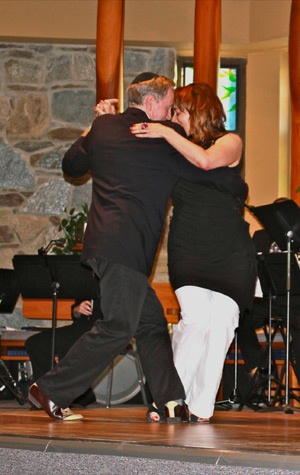by Emily Jacobs
Staff Writer
The 270 audience members were clapping and dancing to the beat at Kolot HaLev’s fourth anniversary concert, held at Temple Emanuel in Kensington on Sunday.

Entitled «Tango Comes to the Land of Milk and Honey,» the concert featured Jewish tangos from Europe, Argentina, Morocco, America and Israel with performances from the 35-person community choir as well as Chazzan Ayelet Piatigorsky, Emmanuel Trifilio and Kolot HaLev artistic director, Cantor Ramon Tasat.
The vocalists were accompanied by Phil Jones and Izabella Tabarovsky, who performed various tangos during the two-hour event.
«The idea [for the concert] at first was to bring together Ashkenazim and Sephardim because we’re always trying to bring Jewish people together,» said Tasat, who also serves as the president of the Shalshelet Foundation for New Jewish Liturgical Music. «I?had been researching Jewish tangos for a while, and I found that there are Latino tangos, Yiddish tangos and Hebrew tangos, so it all fit together very well and that’s where we got ‘tango comes to the land of milk and honey.»
Tasat added that his inspiration for the concert also came from Chazzan Piatigorsky, who put together a concert of Jewish tangos at her synagogue in New York City in January.
While the tango is known for its distinctive rhythmic and harmonic pattern, for Kolot HaLev singer Debra Udey, it’s not only a style of music but «it comes from the heart. Most people look at it and say, ‘Yeah it’s a dance,’ but if you really listen to the music it’s really heartfelt and has an emotion to it that can also be applied to the land of milk and honey.»
Udey, who along with fellow choir members has been rehearsing for the show since last September, described the whole concert as «a unique performance in that we combined so many different types of music and so many artists. It wasn’t just us singing, but our soloists, the ‘bandoneon’ player [Trifilio], everything, it was just a wonderful melange of things that were all so delightful and beautifully interwoven.»
«This concert to me achieved at an even greater extent, the ability that we have to combine text and our voices to promote musical culture,» said Kolot HaLev singer Gene Ridberg. «We’re all very excited about our performance and the general feeling that all the work that we put in with Ramon really paid off in dividends for all of us. We felt that our sound was smoother, and more communicative of what it was that we were trying to convey.»
Judith Klavans, who has sung with Kolot HaLev in past years, praised the cohesive sound of the choir as well as the high energy of all the performers.
«The choir sounded like one voice, rather than 35 voices, which was so impressive. The engagement of the singers reflected the passion of the tango and the dancing was also incredible,» she said. «The creativity of this production enabled the many elements to come together, the music, the instruments, the movement, the singing, the directing, it was really like a piece of performance art.
You didn’t just go to sit and listen, you really experienced the music.»
For Tasat, seeing the love that the Kolot HaLev members have for the music, «is paramount, and really means a lot to me. The most exciting thing is that they’re singing with all of their heart and all of their might. They have grown immensely every year and there is still more that we’re going to accomplish together, and they’ll just keep getting better because their is no ceiling to this.»
Tasat is already planning next year’s concert which will feature a compilation of modern Israeli music.
Fuente: Washington Jewish Week
—————————————————————————————————-
Agradecemos a nuestra amiga Rachel Amado Bortnick por enviarnos este artículo.
 eSefarad Noticias del Mundo Sefaradi
eSefarad Noticias del Mundo Sefaradi

